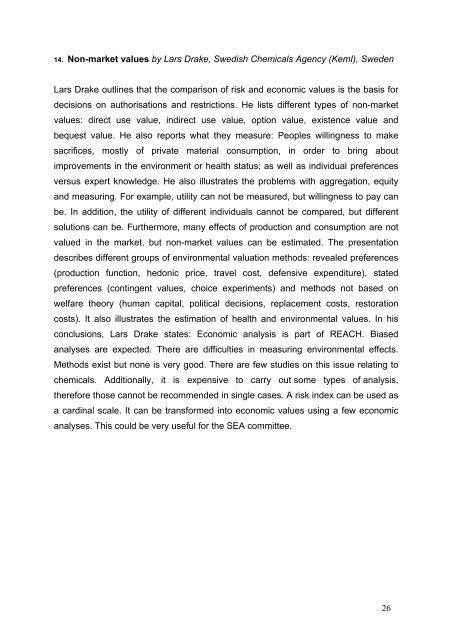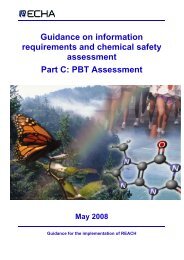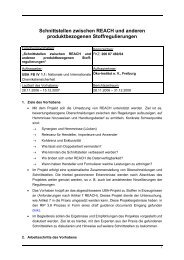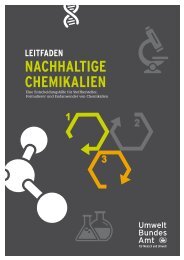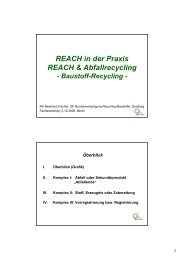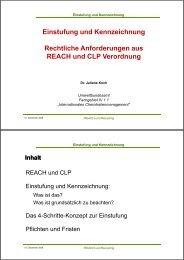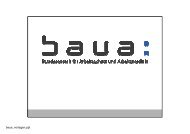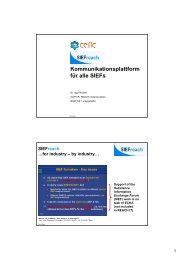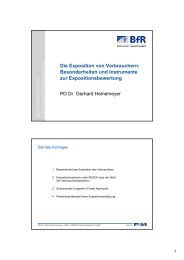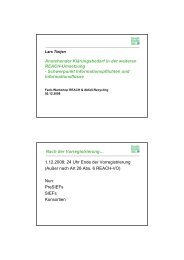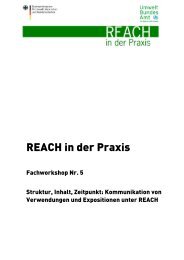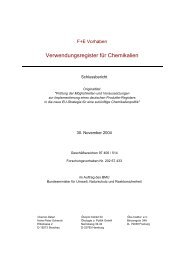“EU-Workshop on Socio-Economic Analysis under REACH ...
“EU-Workshop on Socio-Economic Analysis under REACH ...
“EU-Workshop on Socio-Economic Analysis under REACH ...
Create successful ePaper yourself
Turn your PDF publications into a flip-book with our unique Google optimized e-Paper software.
14. N<strong>on</strong>-market values by Lars Drake, Swedish Chemicals Agency (KemI), Sweden<br />
Lars Drake outlines that the comparis<strong>on</strong> of risk and ec<strong>on</strong>omic values is the basis for<br />
decisi<strong>on</strong>s <strong>on</strong> authorisati<strong>on</strong>s and restricti<strong>on</strong>s. He lists different types of n<strong>on</strong>-market<br />
values: direct use value, indirect use value, opti<strong>on</strong> value, existence value and<br />
bequest value. He also reports what they measure: Peoples willingness to make<br />
sacrifices, mostly of private material c<strong>on</strong>sumpti<strong>on</strong>, in order to bring about<br />
improvements in the envir<strong>on</strong>ment or health status; as well as individual preferences<br />
versus expert knowledge. He also illustrates the problems with aggregati<strong>on</strong>, equity<br />
and measuring. For example, utility can not be measured, but willingness to pay can<br />
be. In additi<strong>on</strong>, the utility of different individuals cannot be compared, but different<br />
soluti<strong>on</strong>s can be. Furthermore, many effects of producti<strong>on</strong> and c<strong>on</strong>sumpti<strong>on</strong> are not<br />
valued in the market, but n<strong>on</strong>-market values can be estimated. The presentati<strong>on</strong><br />
describes different groups of envir<strong>on</strong>mental valuati<strong>on</strong> methods: revealed preferences<br />
(producti<strong>on</strong> functi<strong>on</strong>, hed<strong>on</strong>ic price, travel cost, defensive expenditure), stated<br />
preferences (c<strong>on</strong>tingent values, choice experiments) and methods not based <strong>on</strong><br />
welfare theory (human capital, political decisi<strong>on</strong>s, replacement costs, restorati<strong>on</strong><br />
costs). It also illustrates the estimati<strong>on</strong> of health and envir<strong>on</strong>mental values. In his<br />
c<strong>on</strong>clusi<strong>on</strong>s, Lars Drake states: Ec<strong>on</strong>omic analysis is part of <strong>REACH</strong>. Biased<br />
analyses are expected. There are difficulties in measuring envir<strong>on</strong>mental effects.<br />
Methods exist but n<strong>on</strong>e is very good. There are few studies <strong>on</strong> this issue relating to<br />
chemicals. Additi<strong>on</strong>ally, it is expensive to carry out some types of analysis,<br />
therefore those cannot be recommended in single cases. A risk index can be used as<br />
a cardinal scale. It can be transformed into ec<strong>on</strong>omic values using a few ec<strong>on</strong>omic<br />
analyses. This could be very useful for the SEA committee.<br />
26 26


